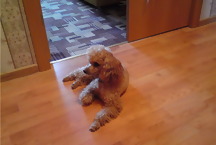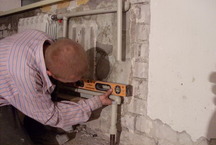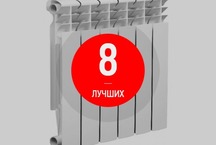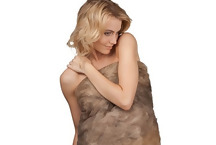Do you know why radiators have a ribbed or wavy surface, and not just a round or flat? How can this affect the choice of radiator for your home? Find the answer in this article.
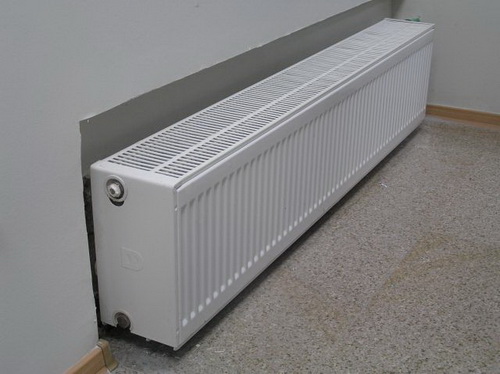
Fact 1
The heating radiator works efficiently if its heat output corresponds to the area of the room (in the radiator characteristics, the term “heat transfer” is also used).
If you buy a radiator, the power of which is much more than necessary, the room will be constantly overheated, this can lead to a decrease in air humidity and oxygen content in it. If the power is insufficient for a given area, you will be cold.
It is difficult to accurately calculate the required thermal capacity of the radiator, for this there are special techniques. Everything is taken into account: climate, building features, parameters of the heat system. But it is possible to estimate this value approximately as follows: for heating a room that has one window of medium size and one wall facing the street, in the middle zone of the Russian Federation at least 1 kW is required for every 10 m². If you have a room of 12 m² - you need a radiator, the heat output of which is not less than 1200 watts.
So, one of the most popular models - aluminum Global ISEO 500 - has a heat transfer of 181 watts per section. A radiator assembled from 12 such sections can effectively heat a standard room with an area of about 20 m². The thermal power of the Royal Thermo BiLiner bimetallic 500, consisting of 10 compact sections, is 1710 W. The model was designed to meet the requirements of aerodynamics for optimal distribution of air flow. Steel radiator Kermi 11 (panel) 110 cm long has a capacity of 1190 watts. Pig-iron 7-section Konner - 1050 W and length of 56 cm.
Fact 2
Choosing a radiator, you need to take into account the working pressure in the heating system of the house.
The working pressure of most sectional steel and cast iron radiators is up to 9 atm, aluminum - more than 12 atm. The technical characteristics of bimetallic radiators indicate values exceeding 30 atm. Stock (the difference between the indicators of the heating system and radiator) is recommended to take at least 2 atm.
In urban high-rise buildings, pressure is maintained up to 9 atm, but it can be increased up to 13 atm (during tests, for example). Therefore, for a city apartment you need to buy an aluminum or bimetallic radiator.
Bimetallic heaters are ideal for high and non-constant pressure. The Global radiators of the Global company, such as the Global VOX-R 500 (aluminum) model or the Global Style Plus 500 (bimetal), performed well. They can be installed in residential, office and commercial buildings with any type of heating system (central, autonomous). During their development, the technical features of Russian heating systems were taken into account.
Steel is recommended to put in private homes, in cottages, where the pressure in the heating system is small. Kermi radiators are often used in cottage construction. The Kermi FTV series has an integrated thermostat.
Fact 3
Water hammer can damage steel radiator.
But solid aluminum racks to similar effects. The material in them retains the natural plasticity, so the probability of a crack is small. For example, Elsotherm aluminum radiators (in particular, AL S 500/80) have been tested at 24 atm, so pressure surges in domestic networks are not terrible for them. They can be installed in buildings of any height and purpose.
Fact 4
The mass of the instrument determines whether the room temperature will change rapidly.
The most massive radiators are made of cast iron. Therefore, their thermal inertia is great - they slowly heat up and cool down, temperature fluctuations turn out to be smoothed.Steel and aluminum, on the contrary, heat up rather quickly and cool down just as quickly.
Fact 5
From the massiveness of the radiator depends on the ease of its installation.
Cast iron not only gives the radiator a high heat capacity and thermal inertia, but also complicates the installation and maintenance of the device. Aluminum and steel radiators weigh much less. One section of the cast-iron Retro 600 with a capacity of 180 W weighs 11.4 kg, and six-section aluminum Calidor Super 350 with a heat output of more than 800 W - only 6.72 kg. The small weight and the sizes facilitate installation of the device and its possible repair.
Fact 6
The sensitivity of the device to the quality of the heat carrier (as a result, reliability and durability) depends on the material from which the radiator is made.
Water is used as a heat carrier in our homes. If the radiator is demanding of its quality, then it can only be installed in heating systems with good water treatment.
For a cast iron radiator, the quality of the coolant does not matter much. Cast iron, from which parts are made, is sufficiently resistant to corrosion. But with long use in the network, where the water is not too well cleaned, plaque forms on the inner walls of the radiator channels (due to the fact that the surface is porous, rough), and this leads to a decrease in heat transfer.
Steel panels are made of low carbon steel, which has good corrosion resistance. But in open systems (in which the tank for draining the excess coolant has an open structure - in this case, the entire heating system communicates directly with the atmosphere), steel radiators become prone to corrosion. Therefore, steel radiators are used in closed type systems.
Aluminum in water is not subject to corrosion if the film formed on its surface is not disturbed, which prevents direct contact of the material with water.
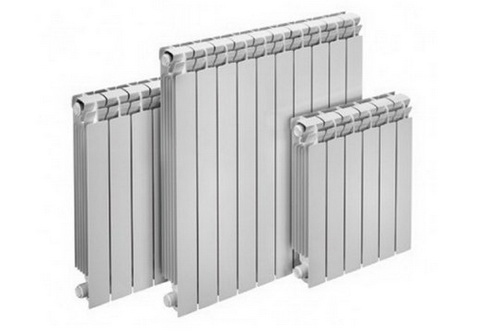
Photo: samara.propartner.ru
To protect aluminum radiators, a special polymer coating is applied to the inner surface of the pipes during the production process. It increases the corrosion resistance of the surface, prevents the formation of plaque and clogging of the lumen of pipes. For example, the Italian model Calidor Aleternum Super 500 has a unique coating developed by Fondital. Radiators with a protective coating work longer (up to 15 years), can be used in heating systems with elevated acid or alkaline values of the coolant: Aleternum allows operation at pH 5-10. It is recommended to install radiators of this series both in urban high-rise buildings and in private houses.
See also: 8 best aluminum radiators
On a reliable bimetallic Rifar Monolit manufacturer gives a guarantee of 25 years. Channels for the heat carrier are made of steel with increased resistance to corrosion. The one-piece design provides durability of the device, the ability to work at pressures up to 100 atm (test - 150 atm) No intersection joints. To the type of coolant, to the quality of preparation, this model is absolutely undemanding, it can work at a sufficiently high temperature - up to 135 °.
Fact 7
Copper fittings must not be installed with aluminum radiators.
The destruction of aluminum by the action of water is greatly enhanced if the parts of the radiator have direct contact with copper. Therefore, when connecting aluminum radiators using steel connectors, plugs, etc.
Fact 8
The presence of intersectional joints and gaskets in the radiator housing adversely affects its reliability.
When buying should pay special attention to the quality of connections and gaskets. Connections - a weak spot in the design of the device. Even in cast iron radiators, intersectional gaskets and nipples can break. Steel sections and tubes are welded together, so these devices are much stronger and more durable. The chance of leakage in a solid radiator is much less.
Fact 9
Thermal power of the radiator depends on the total surface area.
The more heated surface of the device, the more heat it is able to give to the room. The area is increased not only by changing the length and width of the body, but also by adding edges, protrusions. Steel panels are often packaged.
Fact 10
Heat output from the radiator may decrease if the unit is installed incorrectly (very low, too close to the wall).
Much of the heat radiator gives by convection. Therefore, there should be enough space around the instrument for air movement. It is recommended to leave 10 cm of free space above and below, 4 cm to the wall.
Fact 11
Solid radiators can not be increased.
In the aluminum radiator sections are interconnected by nipples. Excess can be removed, the missing can be added, and the damaged can be replaced.
Fact 12
Thermal efficiency of radiators depends on how the coolant is supplied and discharged.
Radiators have a universal design or allow only the top, only the lower connection to the system - this should be considered when choosing. The heat flux from the device increases if water flows to the top and is discharged from below. The flow of coolant from the bottom and removal from the top reduces heat transfer by almost 20%.
Fact 13
Radiators have a different center distance, a different type of connection.
All these parameters of your network also need to know. On one side of the radiator are the pipes (inlet and outlet) in your room or on the opposite? How far apart are they? What is the diameter?
Fact 14
The use of a decorative screen reduces the thermal efficiency of the radiator (on average, by 15-20%).
The screen protects the battery from dust and damage. If you know in advance that your radiator will be covered with a decorative screen, choose a model with more heat output. Decorative grilles, perforated screens reduce heat transfer less.
Fact 15
If you live in an apartment building, it is possible to replace heating radiators with other types of appliances and with other parameters only after agreement.
The heating system is included in the concept of "common property" at home. Heat is distributed to all apartments and common areas in the house. The system is designed so that the heat supplied is enough for everyone, so that the right temperature is maintained everywhere. The design of the heating system at home (including radiators) is described in the approved project documentation.
And now imagine that in one of the apartments they put a radiator, which requires much more heat carrier than the standard ones in this house. The system will be broken, other consumers may suffer. This is just one example. Therefore, before paying for new radiators, you should contact your management company (HOA board, etc.), find out if you can install the selected device in your apartment, and agree on its installation.
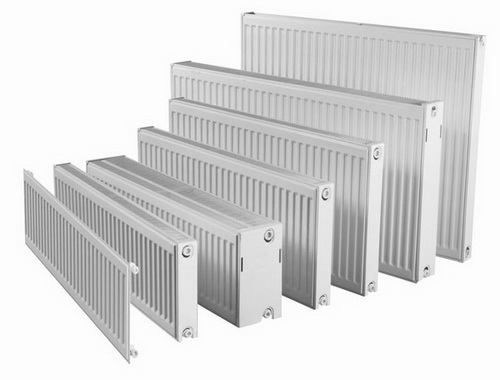
Summarize. Radiators are made of different materials, and this material determines the suitability of the device for inclusion in your heating system. Before buying, you need to find out the parameters of the coolant and the entire system in your home, calculate the heat capacity you need, provide for the location of the instrument and coordinate work with the management company specialists.
